
1,000+ vegan shoes & accessories | VEGAN SALE - GRAB THE LATEST VEGAN STYLES FOR LESS!
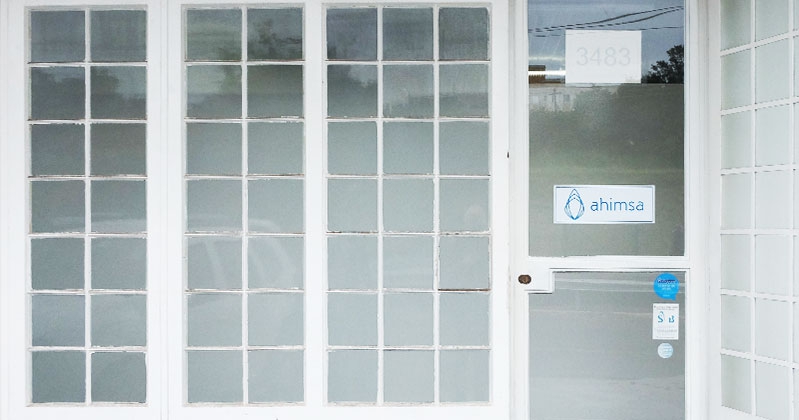
Location
Production Volume
Factory Size
Working Hours
Hours per Week
Salary
Industry Standard
Franca, São Paulo, Brazil
50 pairs/week, 600 pairs/month
11 employees
7 am until 4.30 pm
(including 1 hour lunch break)
42.5 hours
1.800 BRL/month
(+ 275 BRL food bonus)
1.080 BRL/month
BRAND CHECK AHIMSA
HOW A VEGAN SHOE IS MADE
A VISIT TO AHIMSA IN BRAZILIn the small factory town of Franca, 400 km (250 miles) from the pulsating metropolis Sao Paolo, it’s all about team work. Every shoe that is made here passes through the hands of everyone who works here. But that’s not the only thing that makes ahimsa a special brand. The brand was founded by Gabriel Silva, who practically grew up in his father’s shoe factory. His father has been making shoes for large retailers as well as for famous designers for decades. And now, just one door down and separated only by a wall, Gabriel works in his own factory on his very own idea.
After working as a pilot for several airlines, Gabriel found his way back to his father’s profession of making shoes. This is not particularly unusual in Brazil, which is the country with the world’s third largest shoe industry. In Franca alone, which shares its reputation as the shoe capital with Novo Hamburgo in the South of the country, there are around 500 shoe factories for the 350,000 inhabitants to work in.
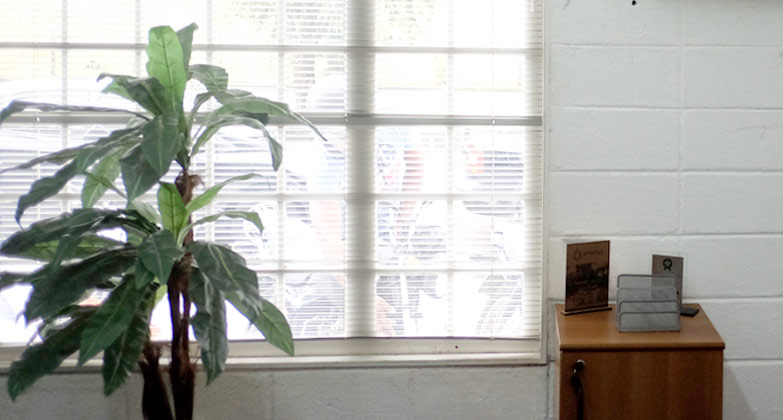
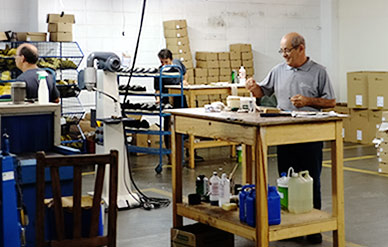
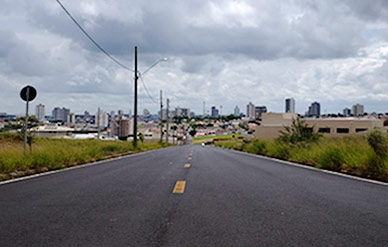
Only one of these factories exclusively makes vegan shoes however, and not only to have a unique selling point on the market; Gabriel knew from the start that he wanted to create a production chain that is as sustainable as possible – one which harms neither animals nor humans.
»Question habits, provoke change, without harm and with lots of respect,« as the brand statement summarizes.
All products that come out of Gabriel’s creative workshop are made from vegan and renewable, sustainable raw materials. From the first designs, on to the choice of materials and to the final assembly of all the separate parts of a shoe, Gabriel is there every step of the way keeping his eye on things.
In march 2016 we paid him a visit in Franca, where he showed us around in his factory and enthusiastically explained every step of his vegan shoe production.
»WE RUN THE WORLD’S ONLY COMPLETELY VEGAN SHOE FACTORY.«
The fact that Gabriel can be involved in the production of his shoes isn’t a given in this business. Most brands must rely on factories that produce for a lot of different brands and can only offer the production of models that fit the machines and production chains that they already have in place. In such factories, it’s not important if it’s a leather or a vegan shoe that they are producing. ahimsa’s factory on the other hand is especially designed and equipped for the type of shoes they want to make. That makes it possible to control the whole production process and to give a guarantee for all the materials and ingredients involved. As a matter of principle, no leather or any other animal product is used anywhere in this factory. »We run what is currently the world’s only fully vegan shoe factory,« says Gabriel as he presents the only adhesive that is used during production. It’s water-based and made just around the corner by a manufacturer in the same neighborhood.
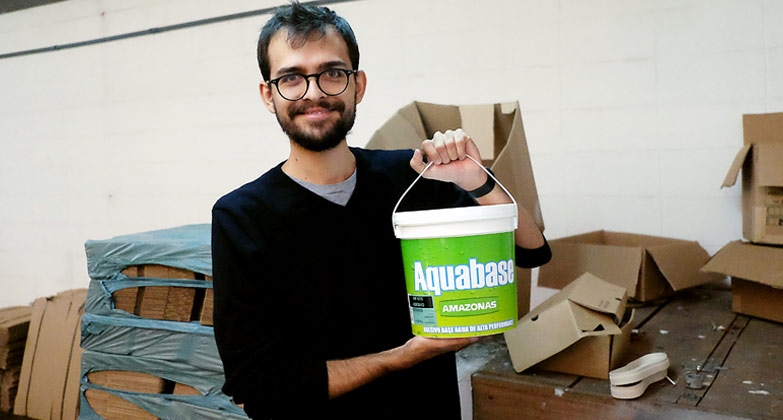
SO HOW IS A SHOE MADE?
No matter if it’s a small factory with ten employees or a large-scale production facility, the procedure for making shoes is essentially the same. There’s always a lot of manual labor involved, since shoe models differ so greatly and need to be stitched in different ways, making it difficult to produce them mechanically. Still, it’s still quite different at ahimsa. There are no assembly lines or conveyor belts and no automated machines in the production room. Rather, every shoe is brought to the next work station by hand and the production volume is still small enough so that everyone knows exactly which shoe or belt they last had in their hands.
DESIGN AND MATERIAL
It all starts with a draft. Using this design idea, the material for the shoe’s upper and the sole is chosen. Gabriel works on the designs himself. Everywhere he goes he is always collecting photos and screenshots on his phone for inspiration. On a shelf in his office there are prototypes and models that he likes as well as new materials or soles that he soon plans to try out on new shoes. His sketches are used to create patterns for the separate parts of the specific shoe model, such as the sides, the heel and the tongue.
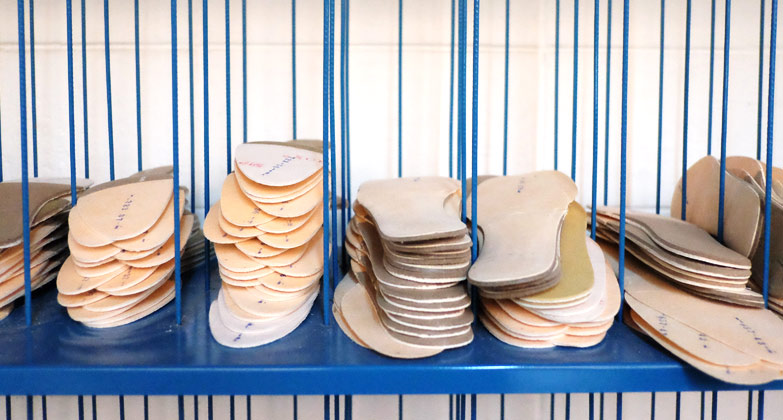
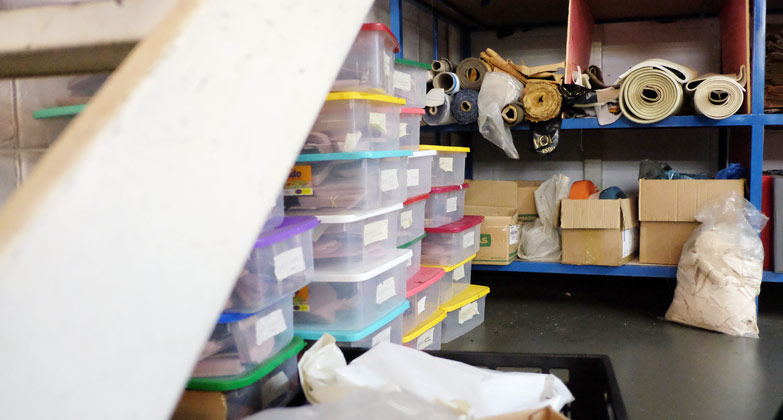
THE PATTERN MAKER
Jacinto is the responsible for the cutting patterns. He has been working for ahimsa since the company was founded. What is usually calculated using a computer is done by Jacinto in his head. His goal is to cut the patterns out of the material in a way that leaves as little waste material as possible. Looking at how little he has discarded shows what an expert he is. The trash is taken away here on Fridays, and on Thursday Jacinto still hasn’t filled one trash can. Waste is also separated here – something which can’t be taken for granted in Brazil.
The result of Jacinto’s work takes the form of bundles of material for different shoe sizes that are stored until that particular size is next up to be produced.
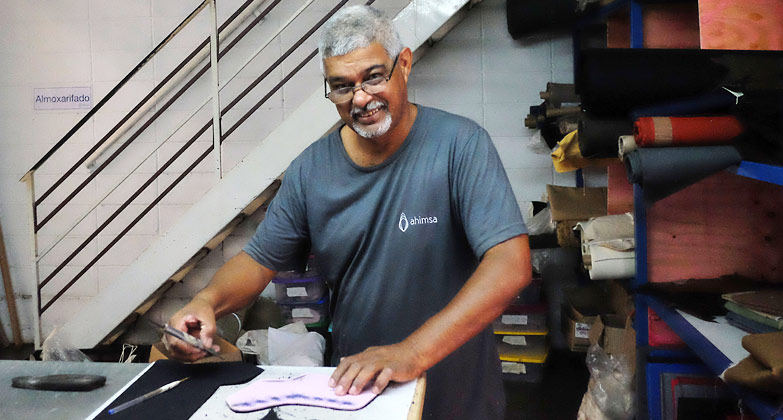
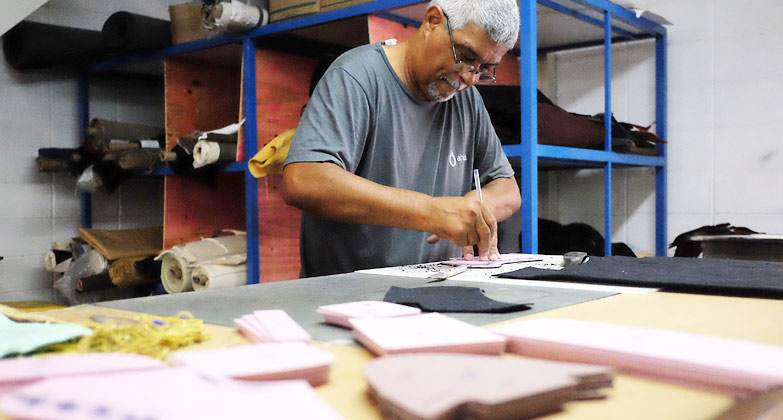
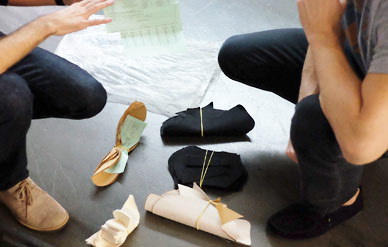
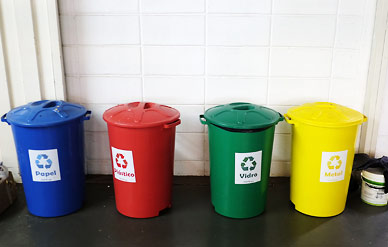
At the sewing station, Antonio takes the prepared pieces of fabric for a model and sews them together. At this point, the lining is also stitched to the material. Using a spray gun, Valdirene sprays water-based adhesive onto the parts that will have padding added between the upper material and the lining, for example on the heel or tongue.
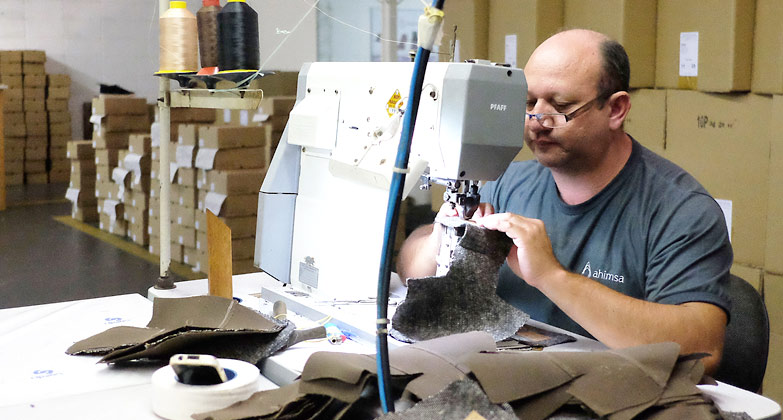
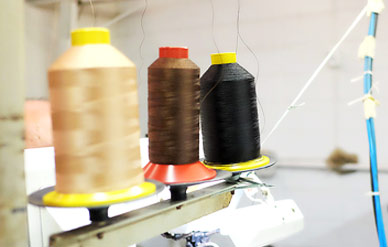
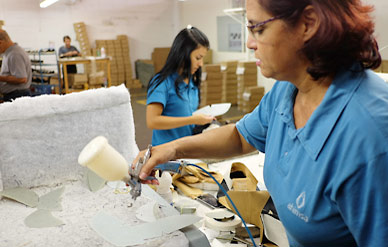
Patricia has worked at ahimsa since the beginning of 2016 and is the newest and youngest member of the team. She works with Valdirene at the sewing station and inserts eyelets for the laces. The stitched upper material, complete with lining and padding, form the whole upper. When held into shape, it almost looks like a shoe.
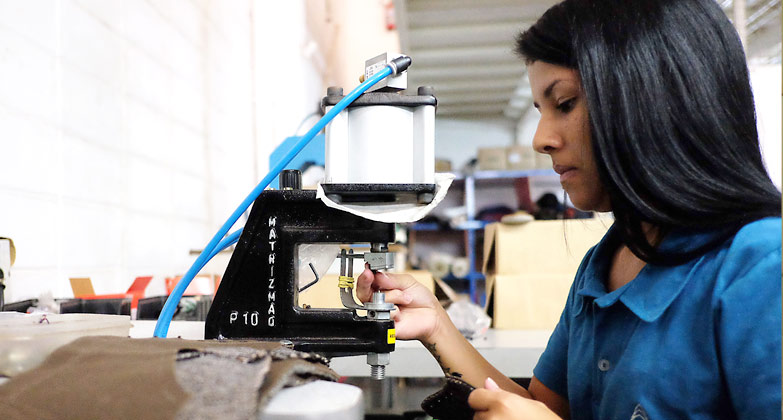
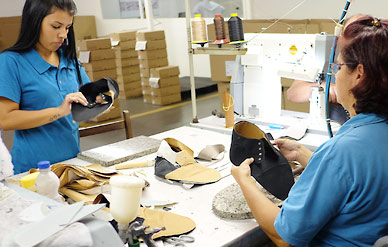
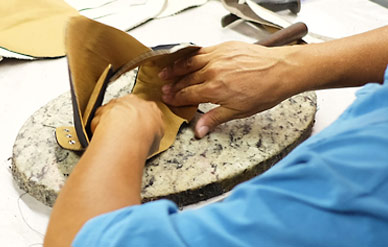
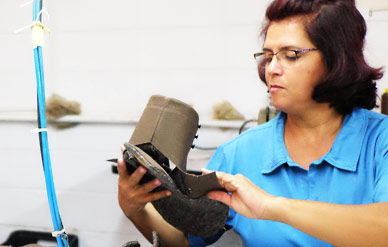
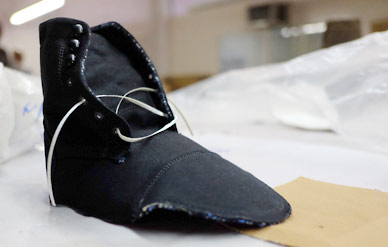
The lasts are at the core of shoemaking, and these foot-shaped wooden blocks are decisive for the shape of the shoe. The last also determines the heel height, the width of the shoe, the shape of the toebox and of course the size of the shoe. While the last serves only as a guide during the design phase, it is imperative for the production of the shoe.
The stitched and glued upper is stitched to the insole and mounted to the last. At ahimsa, that’s Ailton’s task. The last with the upper stretched over it is then slightly moistened and placed in an oven. This is to heat the adhesive and the material, which causes the upper to take the form of the last and gives the upper its shape.
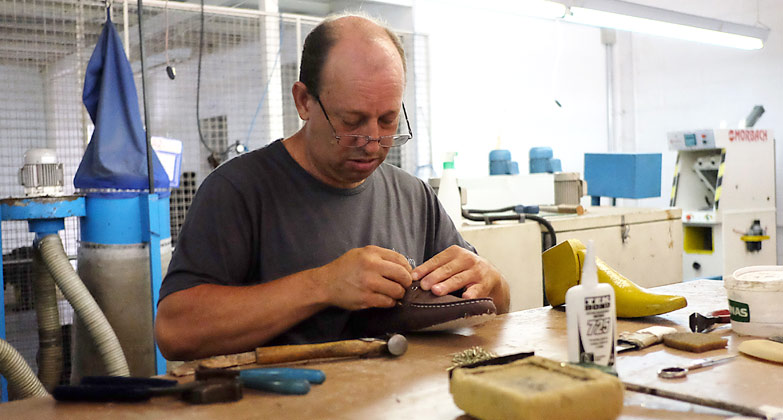
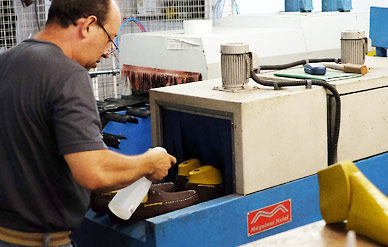
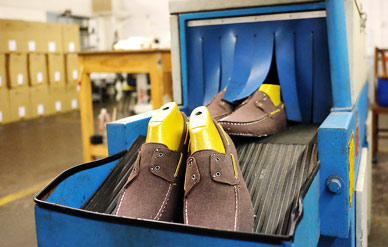
On the top floor of the large factory, there is a large storage for shoe soles. Many manufacturers make their own soles by pressing rubber or synthetic materials into a cast. ahimsa on the other hand sources ready-made soles from a partner factory that is only a few kilometres down the road. The natural rubber that is used to produce the soles comes from the Brazilian rainforest.
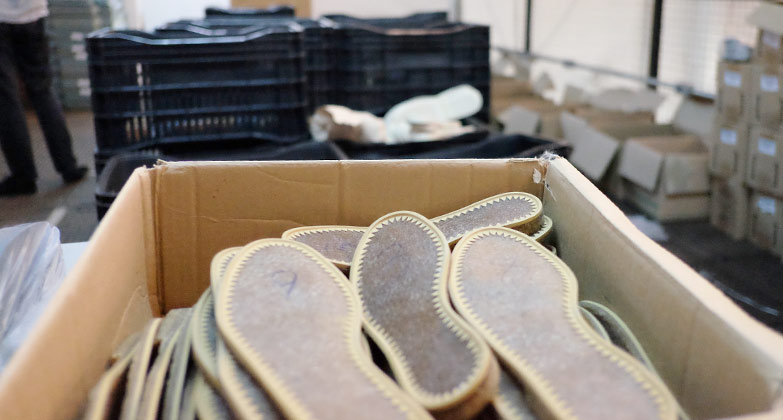
Once the upper has cooled down, Ailton spreads adhesive on the corresponding parts of the upper and sole that will come into contact with each other when the sole is mounted. Both the upper and the sole are then heated in the oven to increase the bonding capacity of the adhesive. Fabiano then carefully joins the upper with the sole. A special machine then applies pressure by creating a vacuum, which ensures the best possible bond between the materials. The result: a vegan sneaker.
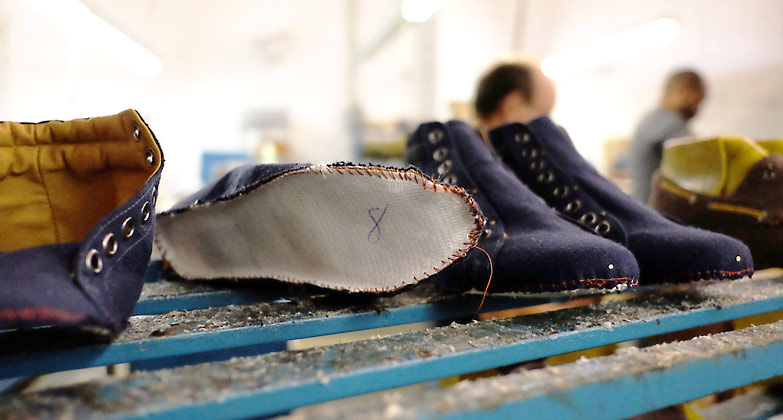
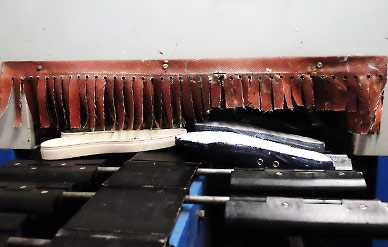
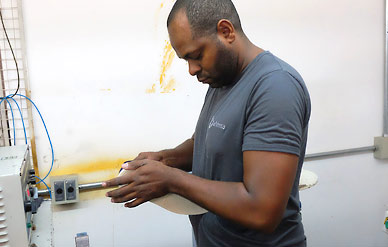
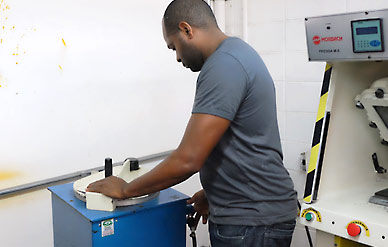
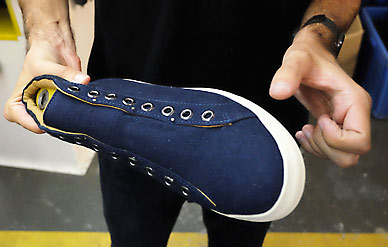
Now the shoes only need laces and then they are finished! Carlos works on this last stage and he has to work like a perfectionist, since he is responsible for the final quality control. At this point, any lint or adhesive residue is removed. Every shoe that you get from ahimsa is checked here by Carlos and packed into a shoebox.
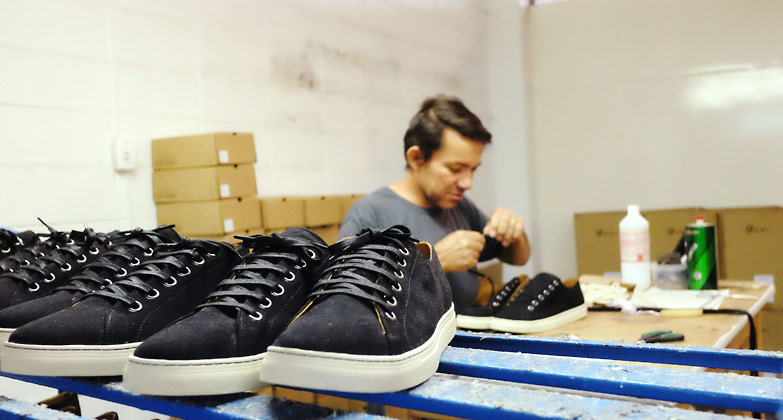
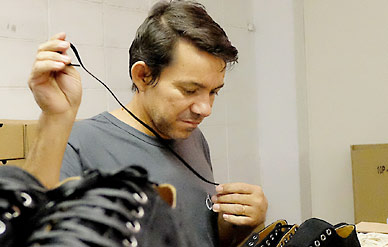
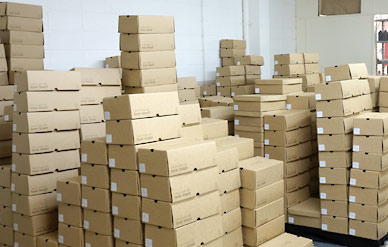
As might be expected, it is much simpler to manufacture a sandal. With the Cravo Sandal for example, the tailored straps are woven together and then inserted into the prepared openings in the sole. The straps are then glued to the underside of the footbed. At this point, a sandal lasts is used, which in this case has a toe cutout. The last molds the straps into the right shape. Finally, the sole is attached and the summery vegan sandals are ready – made 100% by hand!
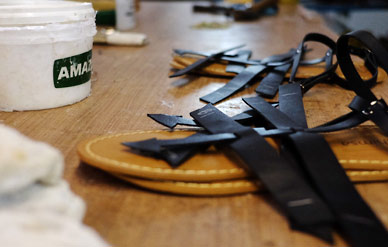
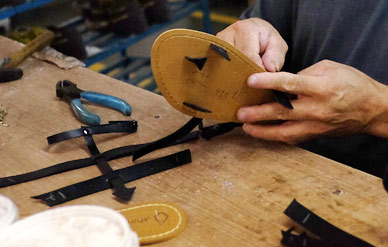
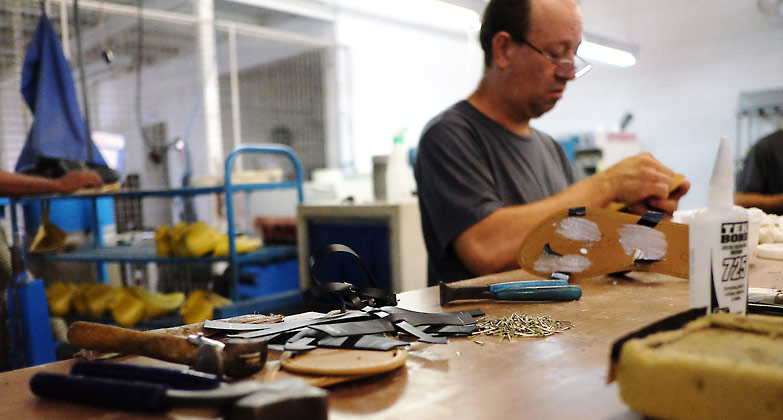
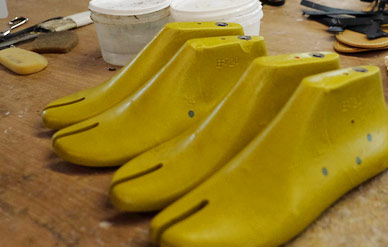
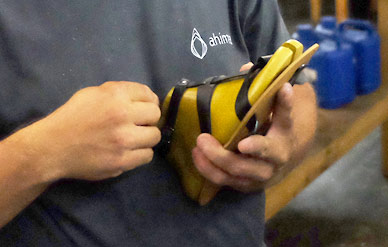
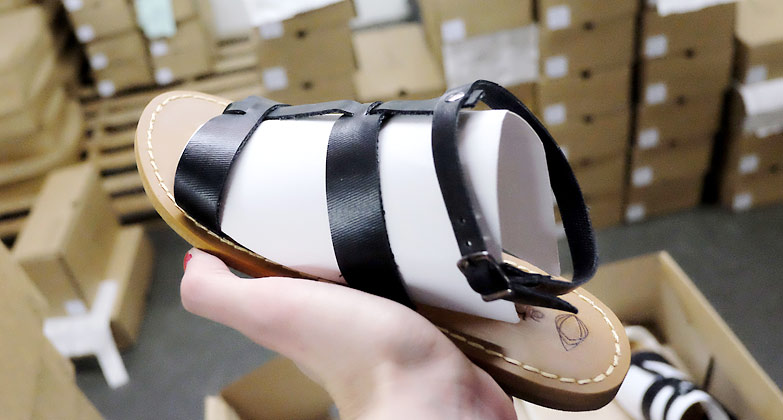
The neatly stacked boxes are waiting to be filled by the office team and sent to customers or retailers like AVESU. Cris and Gustavo take care of this as well as customer inquiries. »We get a lot of calls. When it comes to vegan footwear, people often want exact information on how it is made or which materials are used, or sometimes just want to know how we operate our online shop.« Such inquiries are no problem for ahimsa. It’s not only the modest size of the company that allows transparency, but also the passion and sincerity that the team bring to their roles, all in one location. If there are any tricky questions that the support team can’t immediately answer, they can simply step through to the factory, and Gabriel Silva’s door is always open.
»WHEN IT COMES TO VEGAN FOOTWEAR, PEOPLE OFTEN WANT TO KNOW SPECIFICS.«
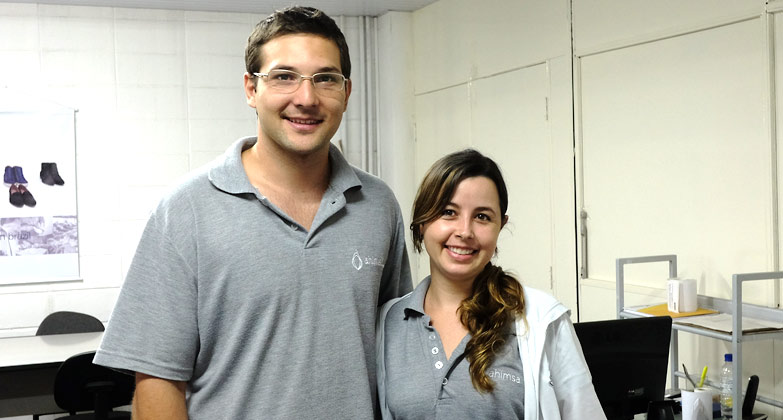
Teamwork is a fundamental principle at ahimsa. Gabriel and his right-hand man Bercson devise a new plan at the start of every week that decides how many models will be produced in which quantities. They stay in constant dialogue with their team and can this way determine what is possible.
During our conversation with Gabriel, it’s clear that his employees are extremely important to him. Many have been there since the beginning, and he’s proud of the average age of his team. Most of them are over 50, and he believes that it isn’t only young people that should be given a chance on the job market. The relaxed, collegial atmosphere of the factory justifies his approach. In the breakroom there are many moped helmets hanging, as most commute to work using Brazil’s most popular and cheapest means of transport. Half-finished cups of coffee litter a large table, and evidently lunch is eaten here communally. »Needless to say, we don’t have a canteen in a company of our size,« Gabriel tells us; »many people bring their lunch from home. We pay an additional monthly food bonus of 275 Real that can be spent using a credit card at the local supermarkets to help our team with food costs."
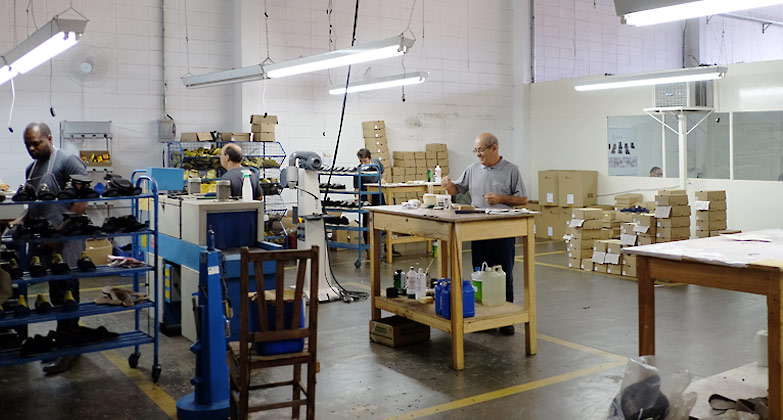
ahimsa’s employees receive on average 1,800 Brazilian Real (470 Euro / 560 USD) for 42.5 hours a week, which is well above the industry standard 1,080 BRL (280 EUR / 335 SUD). Usually, working hours are from 7 am to 4:30 pm. However, when Gabriel steps into his factory on a Friday afternoon, he often finds it to be abandoned. If the team met the weekly production target ahead of schedule, they are allowed to leave early.
»We are still a young company«, says Gabriel. »We are always working on new materials and processes in order to make our shoes better and more sustainable.« Recently, he hired a new production manager, who has since optimized many of the models. The company cannot afford certifications and external inspections. Ironically, the certifications for fair working conditions and sustainability are expensive to obtain and that it’s almost impossible for small companies to get them.
It’s not only for this reason that ahimsa opted for transparency. »Communication within the company is extremely important.« Gabriel wants everyone to understand why he produces vegan shoes and that his factory has nothing to hide. On the contrary; »We want that our customers see where their shoes come from,« explains Gabriel, »who made them and that we as a brand stand behind our convictions.«
Check out AHIMSA's PRODUCTS
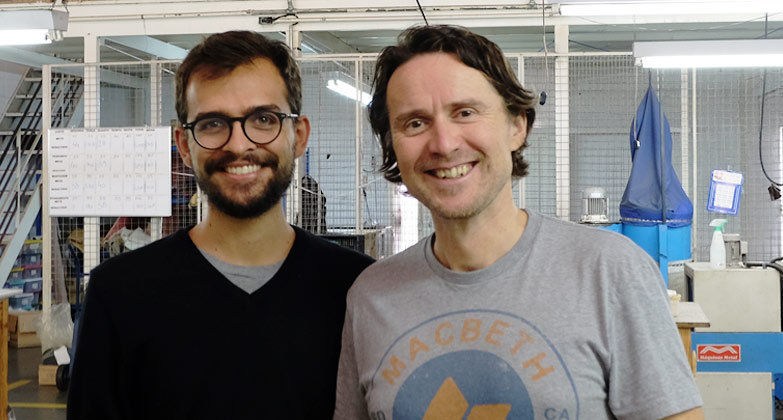 Gabriel Silva and avesu co-founder Thomas are in agreement: vegan shoes are the future.
Gabriel Silva and avesu co-founder Thomas are in agreement: vegan shoes are the future.
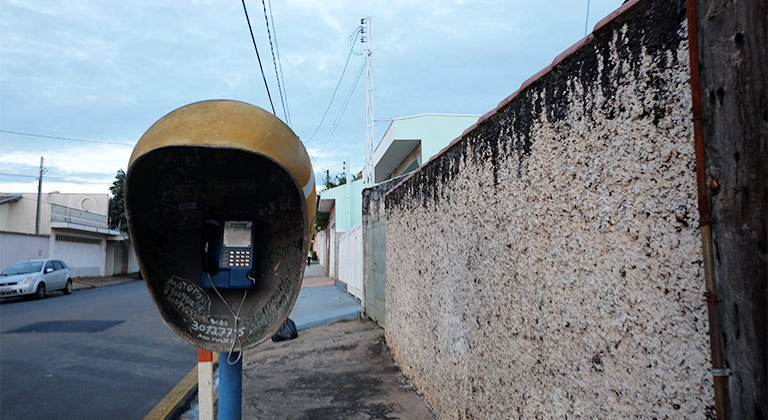
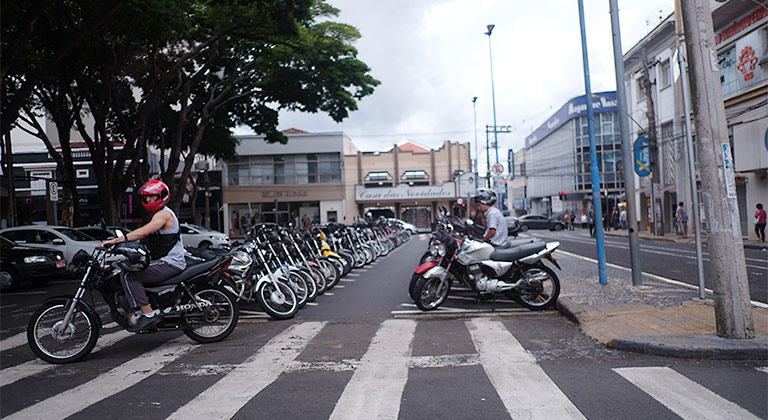
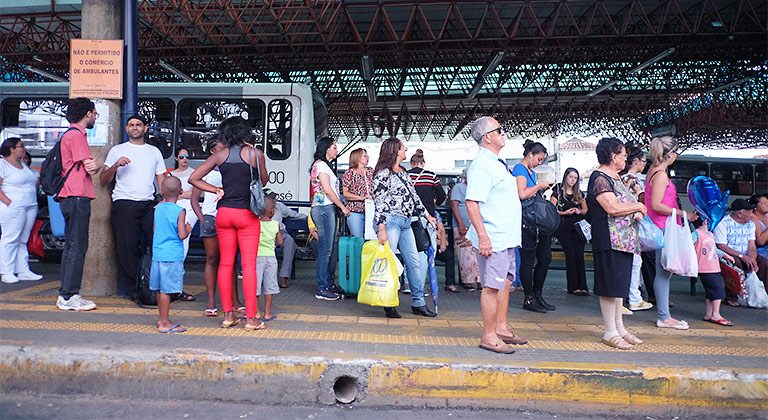
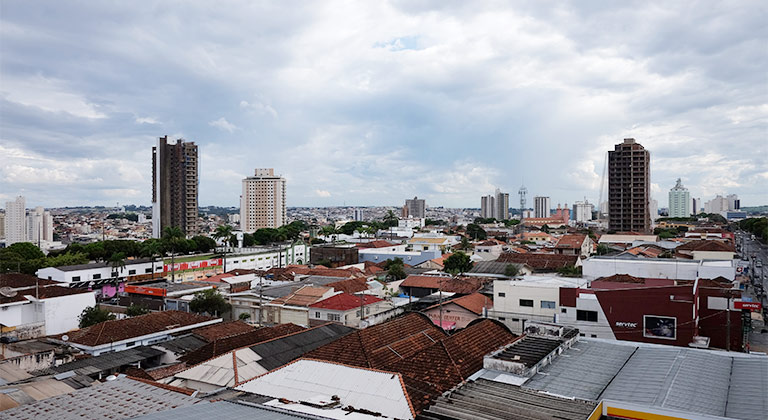
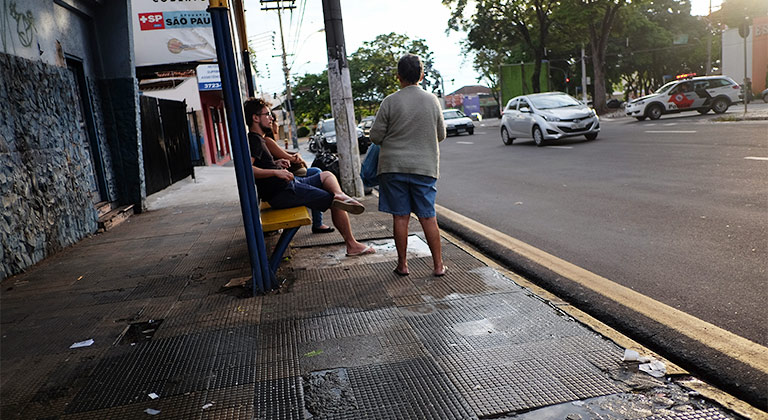
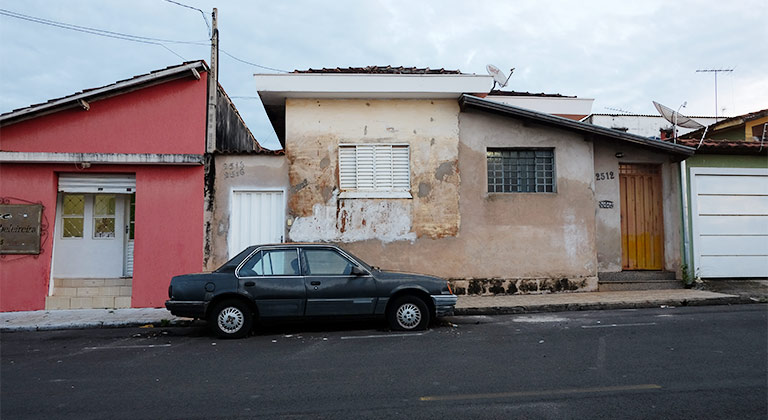
avesu 2016 | Photos: © N. Raeuber



